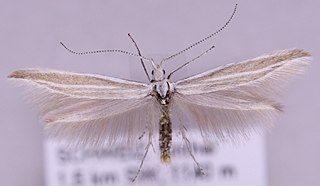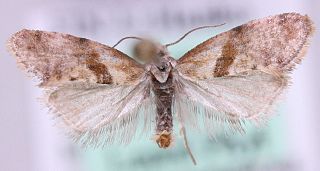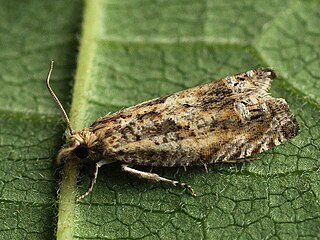
Aster is a genus of perennial flowering plants in the family Asteraceae. Its circumscription has been narrowed, and it now encompasses around 170 species, all but one of which are restricted to Eurasia; many species formerly in Aster are now in other genera of the tribe Astereae. Aster amellus is the type species of the genus and the family Asteraceae.

Aster amellus, the European Michaelmas daisy, is a perennial herbaceous plant and the type species of the genus Aster and the family Asteraceae.

Xenotemna is a genus of moths belonging to the family Tortricidae. It contains only one species, Xenotemna pallorana, which is found in North America, where it has been recorded from Alaska to California, east to Florida and north to Quebec and Ontario.

Aristaea pavoniella is a moth of the family Gracillariidae. It is found from Germany and Poland to Italy, as well as central and southern Russia.
Coleophora amellivora is a moth of the family Coleophoridae. It is found from Fennoscandia to the Pyrenees, Italy and Romania and from France to Poland.
Coleophora autumnella is a moth of the family Coleophoridae that can be found in Czech Republic, Slovakia, Austria, Romania and Spain.

Coleophora conspicuella is a moth of the family Coleophoridae found in Asia and Europe. It was first described by Philipp Christoph Zeller in 1849.

Coleophora rectilineella is a moth of the family Coleophoridae. It is found from France and Italy to Romania.

Coleophora asteris is a moth of the family Coleophoridae found in North Africa and Europe.

Coleophora obscenella is a moth of the family Coleophoridae. It is found from France and Belgium to Poland, the Czech Republic, Austria and Slovenia and from Germany to Italy. It has also been recorded from Romania.

Scrobipalpula diffluella, the Essex groundling, is a moth of the family Gelechiidae. It is found in northern Europe, and central Europe. There are scattered records from Great Britain and the Balkan Peninsula.
Scrobipalpula psilella is a moth of the family Gelechiidae. It is widely distributed throughout the Palaearctic region. It has also been recorded from North America.

Cochylidia implicitana, the chamomile conch, is a moth of the family Tortricidae. It was described by Wocke in 1856. It is found in most of Europe, except Ireland and most of the Balkan Peninsula. Outside of Europe, it is found in Morocco, the Alatau mountains in Central Asia, Iran and China (Xinjiang). The habitat consists of waste ground and verges.

Falseuncaria ruficiliana, the red-fringed conch, is a species of moth of the family Tortricidae. It is found in China (Xinjiang) and most of Europe. The habitat consists of limestone, heathland and moorland.

Phalonidia affinitana, the large saltmarsh conch or large saltmarsh bell, is a species of moth of the family Tortricidae, the subfamily Tortricinae, and the tribe Cochylini. It is found in China, Japan, Korea, Russia and most of Europe. Its habitat consists of salt marshes.

Clepsis clemensiana, Clemens' clepsis moth, is a species of moth of the family Tortricidae. It is found in North America, where it has been recorded from southern Canada, the north-eastern and north-western United States, as well as from northern Utah to northern California.

Thiodia lerneana is a species of moth of the family Tortricidae. It is found in Spain, France, Austria, Italy, Bulgaria, Romania, Lithuania, Russia, Transural, Kazakhstan, Turkmenistan and Kyrgyzstan.

Eucosma aemulana, the obscure bell, is a species of moth of the family Tortricidae. It is found in China, Korea, Russia and most of Europe. It is also found in the United States, where it has been recorded from Colorado, New Mexico, Oklahoma and Utah. The habitat consists of woodlands, chalk downland and cliffs.

Eucosma aspidiscana, the golden-rod bell, is a species of moth of the family Tortricidae. It is found in China, Mongolia, Korea, Japan, Russia, North Africa and most of Europe. The habitat consists of woodlands, downland, waste grounds and cliffs.

Thiodia citrana, the lemon bell, is a species of moth of the family Tortricidae. It is found in China, Japan, Iran, Asia Minor, Turkmenistan, Russia, Kazakhstan, North Africa and Europe. The habitat consists of rough grasslands and dry pastures.














